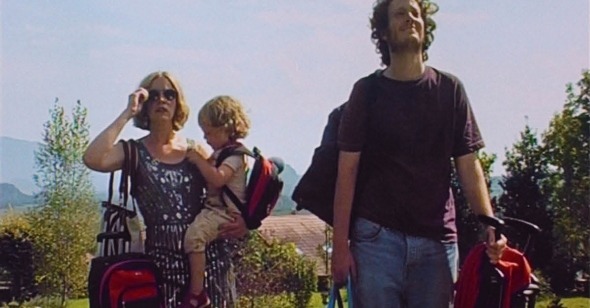Under the Sun
By Clara Cuccaro
Arthur&Diana
Dir. Sara Summa, Italy, no distributor
Arthur&Diana screened Sunday, March 17, at Museum of the Moving Image as part of First Look 2024.
A vintage Renault Espace fuels the drama in Sara Summa’s sophomore feature Arthur&Diana. This work of autofiction follows two real-life and onscreen siblings, Arthur (Robin Summa) and Diana (Sara Summa), as they travel from Berlin to Paris with Diana’s two-year-old son Lupa (Summa’s actual son Lupa Piero Summa). The siblings share custody of their deceased father’s car, in which seemingly benign conversations usually manifest as brother-sister quarrels. Their emotions remain encased within the private space of the passenger compartment, but their feelings and vulnerability are transmissible, allowing this everyday road trip to shift from meandering to profound.
We meet the titular siblings in a rush before they hit the road. Patrick (Benjamin Schwinn), Diana’s husband, stuffs junk food through the passenger window for his wife and son. Chips, candy, and soda are plentiful, but this is not a sustainable diet for anyone, even on the road. Cinematographer Faraz Fesharaki examines these early morning moments in tight close-ups. Diana stuffs her face with chips while Arthur’s eyes glaze over due to his lack of caffeine; soon they will crash, so to speak. A traffic jam puts the two at odds, and we haven’t even left the suburbs of Berlin. This mounting tension between the siblings sets the episodic narrative in motion.
Arthur and Diana are at different points in their lives, but they are not foils for one another. Diana is the stereotypical older sister. She has a child and wakes up at 5 a.m., while Arthur chases girls and sleeps in. Neither has their shit together, but Diana has more on her plate. Her priority is Lupo. Constantly grazing, Diana munches on carrots, strings of licorice, and hunks of parmesan rather than sitting for a meal, suggesting that she has taken a backseat to her own needs and desires. It’s not that Diana is unhappy with her life or motherhood, but she does appear resentful of her brother’s laissez-faire attitude. Arthur is a reminder of what her life used to be when she was a young bohemian living in Berlin, before adulthood. They used to be close, even on equal footing, but now Arthur dreams of finding the elusive “Golden Owl” on an off-road geocaching expedition while Diana just wants to make it from Point A to Point B in one piece.
Shot on a combination of MiniDV, Betacam, and 16mm, Arthur&Diana is laden with nostalgic references. Locations are filmed in color with a handheld camera evoking the Dogme 95 movement. Everything looks grainy, like a forgotten home movie, and the narrative is made up of banal events that make more sense coming from your living room than a big screen theater. Quiet moments like a quick dip in lake country or the unpacking of a suitcase are given attention because they offer rare moments of intimacy between characters.
In its overall sentiment, Arthur&Diana is somehow reminiscent of Agnès Varda’s Le bonheur. The French auteur once described that film as “a beautiful summer fruit with a worm inside.” Le bonheur involves a cheating husband, his wife, and his mistress; the man has his cake and eats it, too. Like Varda, Summa uses color to mask her rage. Bright pops of yellow and red appear frequently, and there are moments when green pastures fill the screen, making the overall composition cheerful and languid, like a hot summer day. But there is simmering anger underneath her highly constructed mise-en-scène. Diana consistently disrupts the tranquility with her presence, whether it's through voiceover—another Varda convention—reflecting her innermost thoughts, or with her physicality. This is evident when Diana randomly finds a gun at a campsite. Rather than turning in the weapon, she lives out a Bonnie and Clyde fantasy in private, pointing the gun at the camera and pretending to shoot, breaking the fourth wall with a laugh, clearly empowered by this phallic object. It’s a daydream filled with desire.
Despite the bickering, there are moments of levity. Both siblings are theatrical and funny as they travel through Europe in their disheveled outfits. Their uncle asks if they’ve “taken showers with their clothes on,” disarming everyone. Music brings the siblings together, but it’s really their shared Renault that does the trick. This great equalizer is rusty and five years past its last inspection, but the car is a reminder of happier times. During a family dinner somewhere in Northern Italy, we learn that Lupo is named after the siblings’ deceased father. They clink glasses in his honor. Summa looks more relaxed in these tender moments. She knows that this car and this road trip will soon fade into the distance. It’s just another phase of life. Everybody moves on.
Arthur&Diana includes an encounter with the police, a flat tire, and a funeral, but the real drama comes from Summa’s performance. The brother-sister quarrels crescendo, revealing her externalized rage, the expression of which contrasts with Le bonheur: in that film, Varda radically embedded her critique of the patriarchy and free love beneath pastoral beauty and bright, sunshiny color, which made the overall viewing experience even more shocking and unsettling. Summa borrows some techniques from Varda, but Diana finally does not conceal her pain and resentment from the audience like the women in Le bonheur. Diana grapples with her role as a mother, sister, and wife openly, showing us that even on a family road trip, there are no off days.
